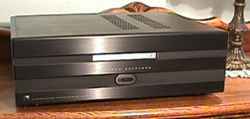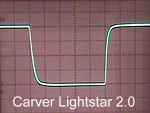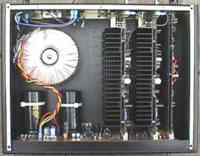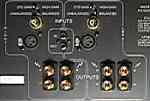Paul Knutson

|
Two Channel Power Amplifier: 300 watts rms/channel into 8 0hms, 20 Hz to 20 kHz Mfr. FR: DC to 100 kHz THD: 0.05% at full output Input Impedance: 100 kOhms (Unbalanced) XLR and RCA inputs Size: 6 1/4"H x 19"W x 16 1/2"D Weight: 40 Pounds MSRP: $2,495 |
| Carver Corporation, P.O. Box 137, Woodinville, Washington 98072; Phone 425-482-3400; Fax 425-482-3401; E-Mail [email protected]; Web http://www.carver.com. |
First Thoughts
I have written then re-written this review a number of times. I couldn't seem to make up my mind about the ultimate performance of the Carver Lightstar 2.0. Each time I'd finish my review, further listening and comparisons to a radically different amp I had on hand would cause me to hit the keyboard and revise certain conclusions.
My thoughts on the Lightstar didn't change too much through this process. I have felt from first listen that the Lightstar was a super performer. Why, then, did I obsess so before finalizing this review? Because even small differences mean a lot in high-performance audio, where big dollars are spent on relatively small steps forward in music reproduction.
Keep in mind as you read this review that I am admittedly biased toward the performance of tube equipment in general. I won't hide it, and I can't deny it. Rare is the occasion that I haven't been impressed by the way music moves me through glass valves. However, my preference for tube amps was put to a formidable test during this review, as the Lightstar held a power advantage over my current SE Triode amp by about 293 watts per channel!
Despite my love of tubes, I keep an open mind. I have no desire to ever debate the ridiculous "tube vs. solid state" issue. Anyone that has the time and energy to debate that topic really needs more hobbies. I'm perfectly willing to embrace any piece of equipment that draws me into the music, regardless of its circuitry. Besides, thus far in my 28 years I've only found one opinion that I truly value -- that of my own ears.
So with all that introduction, where did I end up with the Lightstar? I'm not going to spill all the beans just yet, but if you must have a preview, the 2.0 is a keeper.
Power from Within
One conclusion from which I've never wavered since I first saw this product, is that the Lightstar has a stunning appearance. It isn't flashy or gimmicky-looking, but it's attractive in a strong, solid way. It's masculine. The Lightstar even drew unsolicited positive remarks from my spouse, which is an occurrence just slightly more rare and less likely to happen than the Cubs winning the World Series.
This amp is a substantial chunk of sheetmetal and componentry. It isn't in the "I-lifted-my-Krell-and-now-have-a-hernia" weight class, but if you enjoy swapping equipment with any frequency, make sure you lift the Lightstar with your legs, not your back, everytime you attempt to move it.
As I spend a fair amount of time swapping equipment, I'm a real stickler for good ergonomics in any component. By ergonomics, I'm generally referring to the relative ease, or difficulty, of hooking up a piece of equipment and getting it to function properly. This shouldn't be a chore. Amps are especially important given the number of cables that need to be run to and from them. Given how my component rack is wedged rather tightly in one corner of my listening (dining) room in our apartment, I need an amp that is easy to hook up. I'm pleased to say that the Lightstar excels in this category.
If you choose to look inside the Lightstar you will see build quality that equals or exceeds most anything you might have experienced. Build quality has modest direct correlation with performance, but to ensure that a well-designed circuit functions properly, it is always important to pay meticulous attention to layout and construction. Safe to say that Carver has done a marvelous job putting this amp together. Peering inside, I was immediately be dazzled by the birthday cake-sized toroidal transformer dominating one side of the amp's innards. If the power supply is the lifeblood of a component, the Lightstar 2.0 will live long and vigorously.
The other non-listening item of note is the standby switch on the front panel -- talk about high-tech! There is a main power switch on the back of the amp that provides the power. But don't think for a minute that Carver expects you to reach behind the amp every time you wish to turn it on. What you are supposed to do is turn on the main power and leave it on, then control the daily on/off functions of the amp using the standby switch on the front. This standby switch, or "wake up" switch as I usually call it, activates the amp when you just barely touch the sensor located directly in the center of the faceplate. A trickle current keeps the circuits warm, and the standby switch provides full power. This switch is probably a capacitive one, sort of like the touch sensors in many elevators. Just the slightest touch of the finger activates it, the power meters light up, and solenoids connect the power to the speakers (preventing turn-on thump). Conversely, when you are done listening, you put the amp back to "sleep" by touching the sensor again. Cool.
When you go on vacation for a week or so, it is a good idea to actually reach behind the Lightstar to turn off the main power switch. At all other times, leave the amp in the dozing condition (standby) for best sound. Solid state gear especially (but tubes do too) needs adequate warm-up time to sound its best. I've found a full 24 hours necessary for items like CD players. The Lightstar continued to improve for about eight hours after initial turn-on. I guess all that sand (silicon) takes a while to reach beach temperature.
The Power and the Glory
Listening to the Lightstar was always fun (c.f., Dr. J's Rule # 1). The prodigious bass capability was an immediately striking sonic attribute of this amp. It seemed as though there was an extra octave available at the bottom for music that actually contained information in that low of a frequency range. One such CD is "Decksanddrumsandrockandroll" by the Propellerheads, a recent addition to my small collection of electronic music. After the great Shirley Bassey (who is doing a guest spot on this one song only) finishes her sassy and soulful introduction to "History Repeating", the beat kicks in and the woofers had better watch out! The Lightstar's seemingly limitless bass capabilities will grab hold of any speaker and take it on a sonic thrill ride.
With 300 watts available at 8 Ohms, and double the power available each time the impedance is halved right down to 1 Ohm, it's not unreasonable to expect that kind of bass output capability from the Lightstar. The unique and very effective power supply is unquestionably responsible for the impressive power output. In my San Francisco city-dweller apartment, I never came remotely close to reaching the limits of the Lightstar. I'm not sure it even has a limit in any conceivable home setup. Interestingly, the amp never got more than barely warm during my listening. There aren't many wasted (heat-dissipated) watts in the Lightstar.
While the quantity of the bass from the Lightstar was impressive, I wasn't quite as taken by the pitch differentiation between bass notes. I prefer an amp to re-create bass as a series of individual notes, not just low frequency sounds. While the Lightstar was good in this regard, it wasn't exceptional. Maybe it was a matching problem with my preamp or speakers because a shortcoming in this area doesn't make sense. I have heard some less powerful amps that I thought did the bass pitch thing better, but none had the raw, gut-thumping bass slam and speed of the Lightstar.
On a side note, there is a "high gain" switch on the back of the amp near the input connectors that increases the amp's input sensitivity. While I didn't need additional gain, I tried the switch to check its function. Curiously, my purely subjective opinion was that the amp's tonal character was somewhat fuller, darker and even stronger in the bass regions when the "high gain" switch was engaged. Was this a good thing? No, not really, but since I didn't need the "high gain" mode anyway, and I suspect few of you will either. I simply didn't use it. On the other hand, if you like the extra bass, you could use the input and just turn down the volume control.
With all that power available, the dynamics of the Lightstar were stirring. The capabilities of my CD player or turntable were the only limiting factors in dynamic performance. Sounds like rimshots and fff orchestral blasts were more realistic and had greater impact through the Lightstar than with other amps I've had in my system. There are a few cuts on Harry Connick Jr.'s "We are in Love" album that provide an amplifier every opportunity to demonstrate that it can punch out the dynamic contrasts. To do this properly, an amp must be able to start and stop quickly -- ideally, if you don't know it's coming, a casual listener should be startled when the staccato horn blasts scream out at you on certain songs from this album. I've heard these songs too many times to still be jolted, but the I was nonetheless impressed by the Lightstar's ability to deliver this effect realistically. The highest possible marks are given to the Lightstar for dynamics.
Apples to Oranges
During my time with the Lightstar 2.0, I compared it with the other amp I happen to have on hand, an Audio Electronic SE-1. I didn't really do a head-to-head comparison between these two amps, nor did I attempt any A/B/X double-blind testing. Life is too short for that stuff. I simply switched between amps as the urge hit me.
For those who aren't familiar with the SE-1, it is a single-ended tube amplifier based on the vaunted 300B triode output tube. Power output is a whopping 7 or 8 wpc, with no more available at lower impedances -- you get your handful of watts and that's it.
Consider this -- could these two amps be any more different? I don't think so. Is one a clearly superior music-maker in all respects? I don't think so.
Of course, this is an rough comparison of radically different products, so I won't spend a lot of time comparing every strength and weakness. After all, this isn't a review of the SE-1. You will recall, however, that at the beginning of this review I mentioned how my thoughts on the Lightstar changed a few times while writing this review. It was because of the SE-1 that I struggled to be resolute on my thoughts about the Lightstar.
The one area where I thought the Lightstar clearly fell short of the SE-1 was in the development of a soundstage, specifically in the aural illusion that performers are situated in various positions, front-to-back, on a stage. Granted, a lot of this is dependent on the recording, but with recordings that were done live with the right microphone placement, the SE-1 was better at placing the performers in this manner. The Lightstar, in comparison, seemed to move everything forward to a common plane about even with my speakers or a bit behind. In contrast, the SE-1 placed certain performers properly forward, but placed others way back on the stage.
Some of you may not give a lick about soundstaging, but I do. When I close my eyes and listen to music, I like to be fooled into "seeing" the performers. While the Lightstar was always a clean window to the music, it didn't suspend disbelief like the SE-1. (Again, please remember that I am a tubeophile.)
Listening to great vocal recordings at moderate volume levels was also more pleasing through the SE-1. The Lightstar was no slouch on vocals, but I thought some of my favorite vocalists like Etta James and Mel Torme sounded more "human" through the 300B amp, with a wholeness and body to their voice that my ears immediately perceived as lifelike, as opposed to reproduced. As many of you know, the 300B triode is the stuff of legend and fable for its ability to reproduce midrange -- accolades that are well-deserved in my opinion. Whether this is attributable to the even vs. odd ordered harmonic spectra is a topic being researched as we speak. We'll learn more about how we hear and perceive reproduced sound as time goes; in the meantime, my ears don't lie, and I prefer the 300B single-ended triode sound on certain types of music.
Final Thoughts
I'll probably mention this in every review I write, but reviewing components is basically unfair to both the equipment and the manufacturer -- there are simply too many variables in system set up to have any degree of certainty that the subjective conclusions reached in a review are valid. Not to mention the vagaries of electrical interaction between components (or "synergy" as some word-of-the-day types prefer to call it) that can make or break your impressions. Bottom line, my advice is to read every review (here and elsewhere) with a grain of salt, knowing that your mileage may vary.
With that said, the Carver Lightstar remains an easy amplifier to recommend. I'd let my closest friends buy this one. Its universal adaptability will allow it to perform spectacularly in 95% of the systems out there. I must admit, when using cone-based speakers like my Spica TC-60s, the Lightstar 2.0 will do things that tube amps may never do.
Like I mentioned at the beginning of the review, this is an amplifier that is always fun to listen to. Its dynamic capabilities are all you will ever need in a home system and its ability to rock the house with bass output is without peer in my experience. Though I didn't test the Lightstar in such a setting, for those of you that combine home theater with your hi-fi, you must have the Lightstar on your short list of candidates. One can only imagine what it would do with "Jurassic Park".
I haven't discussed value - a topic dear to my heart - but at $2,495, the Lightstar 2.0 is realistically priced near the point where diminishing returns kick in as the price continues to rise. The Lightstar can walk with a confident swagger deep into the land of higher priced competition. The amp doesn't color or editorialize in any egregious way, remaining truthful to the signal it's fed. If you want a high-performance amp that simply amplifies, really amplifies, then Lightstar technology is high on the list.
Paul Knutson
Notes from the Editor:
Measurements on the Lightstar 2.0 showed
it to have 0.07mV DC offset, one of the lowest I have ever seen.
 Sinewave response was down 3 dB
at 105 kHz from the measurement at 10 kHz. The ±10 V, 10
kHz square wave response indicated no ringing or overshoot.
Sinewave response was down 3 dB
at 105 kHz from the measurement at 10 kHz. The ±10 V, 10
kHz square wave response indicated no ringing or overshoot.
The inside of the chassis is neatly arranged
with a 750 kVA toroidal transformer and two large power capacitors
(9,000 µF each) on one side, and the circuit boards on the
other side. The power supply has 130 Joules of energy storage,
based on ±120V DC on the capacitors.  There are
two high current output devices per channel, and the digital power
supply switching frequency is 200 kHz, allowing 10 switchings
for the highest frequency in the normal audible band. Because
the digital switching power supply follows the signal voltage
very closely, there is very little heat that has to be dissipated.
Indeed,
There are
two high current output devices per channel, and the digital power
supply switching frequency is 200 kHz, allowing 10 switchings
for the highest frequency in the normal audible band. Because
the digital switching power supply follows the signal voltage
very closely, there is very little heat that has to be dissipated.
Indeed,  the amplifier never got very warm,
even with high volume. The rear panel has heavy duty jacks and
binding posts. Like other Carver products, all the jacks and posts
are well marked with large white lettering so that you can see
what you are connecting when looking over the top of the chassis.
the amplifier never got very warm,
even with high volume. The rear panel has heavy duty jacks and
binding posts. Like other Carver products, all the jacks and posts
are well marked with large white lettering so that you can see
what you are connecting when looking over the top of the chassis.
My own listening experience with the Lightstar 2.0 confirmed Paul's observations that it has prodigious bass. In fact, the bass increases not only when using the high sensitivity switch, but also with the balanced inputs! I realize that this is a "coloration" of sorts, but the sound quality did not change per se. It was like having a bass boost in the circuit, but without adding a tone control potentiometer into the signal path.
Although the Lightstar 2.0 is out of production (Carver built 100 of them, and they all sold), it is the Lightstar technology that we are really reviewing here. Carver plans to incorporate this technology into other products in the future, such as surround sound components. The 2.0 is an expensive amplifier to construct and, like many companies that sold a high proportion of their line to Asia, they were hit hard by the financial crisis in that part of the world, so they have pulled in their belt to reorganize. After personally visiting their factory and seeing how efficient this fine company is, I am convinced they will emerge better than ever, and we will see lots of excellent products, including Lightstar.
- JEJ -
© Copyright 1998 Secrets of Home Theater & High Fidelity
Return to Table of Contents for this Issue.

